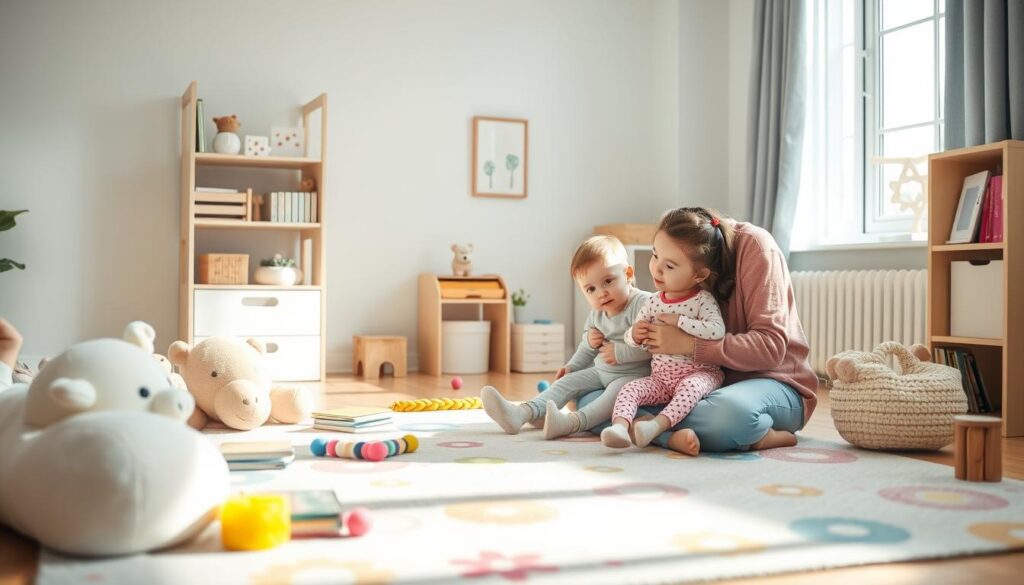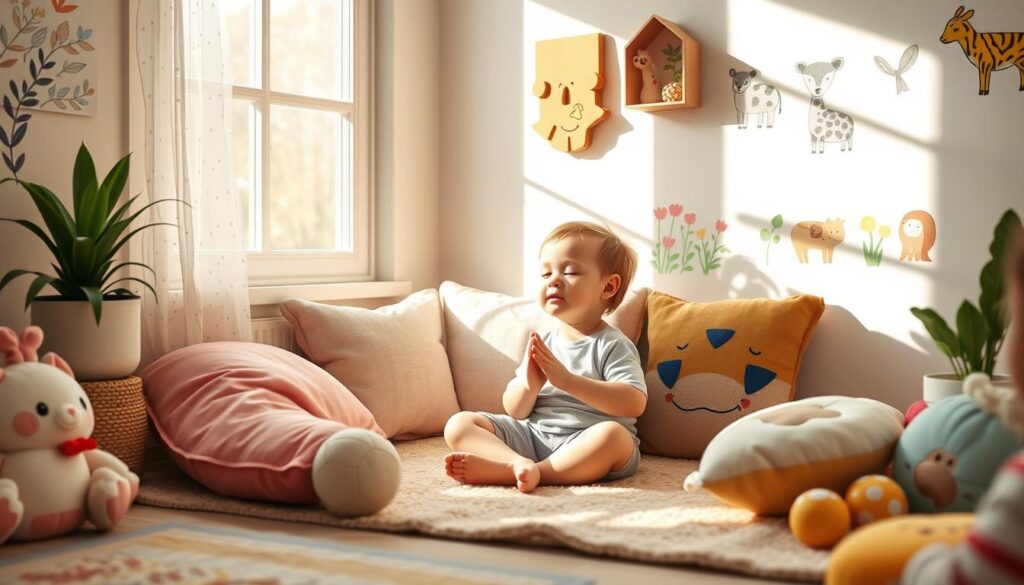As a parent, you want the best for your child. This includes teaching them discipline in a positive way. Gentle techniques can help you do this, creating a supportive environment for your child to grow.
These techniques are key in teaching your child to behave well and feel confident. But, how can you use them effectively? This will help your child become a capable and responsible person.
Key Takeaways
- Using gentle techniques in toddler discipline helps create a supportive environment for your child to develop positive behaviors.
- Gentle techniques promote a strong sense of self-discipline in children.
- Toddler discipline is important for teaching children right from wrong.
- Gentle techniques can redirect negative behaviors in children.
- Consistency is key when using gentle techniques in toddler discipline.
- Gentle techniques help build trust between you and your child.
- Effective toddler discipline sets the stage for a lifelong positive relationship with your child.
Understanding the Toddler Mind: Why Traditional Discipline Often Fails
As a parent, you want the best for your child. You seek ways to help them grow and behave well. But, traditional discipline doesn’t always work. This makes you wonder why your toddler isn’t listening.
Toddlers learn a lot from their world. Their brains are set up to respond to positive actions. Knowing how toddlers develop helps us see why old discipline methods don’t work. For example, they’re learning to control their feelings and might get upset by strict rules.
Brain Development in Toddlers
Brain growth is key for toddlers to understand discipline. Their brains are not fully formed yet. They can’t handle complex rules or reasons. So, using simple and clear language is better for teaching good behavior.
Emotional Regulation Capabilities
Toddlers struggle with controlling their feelings. This can cause tantrums. Using empathy and validation helps them manage their emotions better. This makes tantrums less common and creates a calmer home.
| Developmental Stage | Characteristics | Effective Parenting Strategies |
|---|---|---|
| Toddlerhood (1-3 years) | Learning to regulate emotions, testing boundaries | Positive reinforcement, empathy, validation |
| Early Childhood (4-6 years) | Developing social skills, learning to cooperate | Encouragement, positive role-modeling, clear communication |
Understanding each stage of development helps you parent better. Use positive methods to encourage good behavior. Remember, patience, consistency, and responding to your child’s needs are key. Use positive tips and strategies to help them grow.
The Foundation of Gentle Parenting Approaches
Gentle parenting creates a calm and supportive space for toddlers. It makes them feel safe and secure. This is key for managing toddler behavior well. It builds a strong bond between parent and child, based on respect and trust.
Key parts of gentle parenting include using positive words and focusing on behavior, not personality. It also encourages talking openly. These methods help manage your toddler’s actions gently and lovingly. This way, your home becomes a peaceful and loving place for your child.

- Encourages healthy emotional development
- Builds a strong, loving relationship between parent and child
- Helps manage toddler behavior in a gentle and loving manner
Using gentle parenting in your daily life makes your home a better place for your child. Gentle parenting isn’t about being too lenient. It’s about being thoughtful and careful in how you handle toddler behavior. With patience, love, and consistency, your child will grow into a happy and well-adjusted person.
| Approach | Benefits |
|---|---|
| Gentle Parenting | Encourages healthy emotional development, builds a strong relationship, and helps manage behavior |
| Calm Parenting | Creates a peaceful home environment, reduces stress, and promotes positive communication |
Essential Components of Effective Toddler Discipline
Understanding the key parts of toddler discipline is vital. By using supportive child guidance and nurturing methods, you can create a positive space. This space helps your child grow and develop healthily.
Effective toddler discipline involves several important elements. These include:
- Setting clear boundaries to help your child understand what is expected of them
- Maintaining consistency to ensure your child knows what to expect
- Building an emotional connection to create a strong bond with your child
- Using positive reinforcement to encourage good behavior
By combining these elements, you can create a supportive environment. This environment helps your child learn self-regulation and understand boundaries.

The aim of toddler discipline is not to punish but to teach. Using nurturing methods and supportive guidance helps your child become happy and well-adjusted.
Discipline is not about punishing your child, but about teaching them the skills they need to succeed in life.
Creating a Supportive Environment for Better Behavior
As a parent, you have a big role in shaping your toddler’s behavior. By making a supportive environment, you can help them act better. Peaceful parenting solutions help build a strong, loving bond with your child. This is key for their emotional and social growth. Using gentle techniques like positive reinforcement and redirection is very effective.
Here are some ways to make a supportive environment:
- Encourage open communication: Listen to your child and validate their feelings.
- Set clear boundaries: Establish rules and consequences while being consistent and fair.
- Practice positive reinforcement: Praise and reward good behavior to encourage its repetition.
A supportive environment is vital for your child’s growth. It helps them learn self-control and self-discipline. By using peaceful parenting solutions and gentle techniques, you create a loving space for healthy growth.

By using these strategies, your child will grow into a confident, capable, and compassionate person. Remember, making a supportive environment takes patience, love, and dedication.
| Technique | Description |
|---|---|
| Positive Reinforcement | Encouraging good behavior with praise and rewards |
| Redirection | Redirecting unwanted behavior into a more desirable one |
| Open Communication | Listening to and validating your child’s feelings |
Gentle Techniques That Actually Work with Toddlers
Using gentle techniques is key when teaching toddlers discipline. These methods help them learn good behavior and grow well. They help your toddler learn to control themselves, feel for others, and know who they are.
Some gentle methods include redirection methods. This means showing your toddler a better choice instead of what they want. Another way is time-in instead of time-out. This means spending good time together to calm down. Natural consequences also teach them about what happens when they act.
Redirection Methods
- Offer a alternative toy or activity
- Use positive language to redirect behavior
- Set clear boundaries and expectations

Time-In Instead of Time-Out
Time-in means spending quality time with your toddler to help them feel better. You can read a book, sing a song, or just cuddle.
| Technique | Description |
|---|---|
| Redirection | Redirecting your toddler’s attention to a more acceptable behavior |
| Time-In | Spending quality time with your toddler to help them regulate their emotions |
| Natural Consequences | Allowing your toddler to experience the natural consequences of their actions |
Natural Consequences
Natural consequences teach toddlers about cause and effect. For example, if they throw a toy, it gets taken away.
Managing Common Toddler Behavioral Challenges
As a parent, you might face challenges like tantrums, aggression, and defiance with your toddler. To tackle these, use positive parenting tips and calm parenting approaches. These methods help create a supportive space for your child’s growth and good behavior.
Here are some common issues and how to solve them:
- Tantrums: Use redirection methods to distract your child and provide a calm environment.
- Aggression: Practice emotional validation to help your child understand and manage their feelings.
- Defiance: Set clear boundaries and use positive reinforcement to encourage good behavior.
By applying these positive parenting tips and calm parenting approaches, you can help your child learn to control their behavior. This is done in a healthy and positive way.

Every child is different, so what works for one might not work for another. Be patient, consistent, and supportive. Work with your child to find the best way to meet their needs.
By working together and using gentle techniques, you can create a nurturing environment. This encourages healthy development and behavior, helping your child thrive.
| Behavioral Challenge | Solution |
|---|---|
| Tantrums | Redirection methods, calm environment |
| Aggression | Emotional validation, positive reinforcement |
| Defiance | Clear boundaries, positive reinforcement |
Communication Strategies for Peaceful Parenting
Effective communication is key to toddler behavior management and creating a supportive environment for your child. By using age-appropriate language, you can help your toddler understand what is expected of them. This reduces tantrums and misbehavior. This approach to supportive child guidance fosters a sense of trust and respect. It lays the foundation for a strong, healthy relationship.
Some strategies for effective communication include:
- Using simple, clear language that your toddler can understand
- Validating your child’s feelings, even when setting limits
- Employing non-verbal communication techniques, such as gestures and facial expressions
By incorporating these strategies into your daily interactions with your toddler, you can promote positive behavior and healthy development. Remember, supportive child guidance is about creating a nurturing environment. It encourages open communication and mutual respect. With patience, consistency, and effective communication, you can help your toddler develop the skills they need to thrive.
As you work to develop your communication skills, keep in mind that toddler behavior management is an ongoing process. Be patient with yourself and your child, and don’t be afraid to seek guidance when you need it. With time and practice, you can create a more supportive and loving environment for your toddler to grow and develop.

Preventing Meltdowns Before They Happen
As a parent, you aim to create a nurturing space that fosters positive behavior and growth. By employing nurturing discipline methods, you can ward off meltdowns. It’s important to recognize early signs, like changes in your child’s mood or body language.
Setting up predictable routines is key to avoiding meltdowns. This means having a daily plan for meals, sleep, and activities. Such routines offer stability, helping your child feel secure and less likely to throw tantrums. Peaceful parenting solutions like these can significantly reduce stress and strengthen your bond with your child.

- Encouraging communication and expression of emotions
- Providing opportunities for physical activity and outdoor play
- Offering healthy snacks and meals to prevent hunger and frustration
By being proactive and using these strategies, you can foster a supportive environment. This environment encourages positive behavior and healthy growth. Remember, every child is different. Be patient, flexible, and attentive to your child’s needs. This approach will help prevent meltdowns and nurture a happy, healthy relationship with your child.
| Strategy | Benefits |
|---|---|
| Reading early warning signs | Helps prevent meltdowns, promotes positive behavior |
| Creating predictable routines | Provides sense of security and stability, reduces stress |
| Encouraging communication and expression of emotions | Helps child develop emotional intelligence, reduces tantrums |
Building Your Toddler’s Emotional Intelligence
As a parent, you have a big role in shaping your toddler’s emotional smarts. Using gentle ways like validation and empathy helps your child learn to control their feelings. This helps them deal with tough times and feel good about themselves and others.
Some key strategies for building emotional smarts in toddlers include:
- Labeling and validating their emotions, which helps them develop emotional awareness and understand their feelings
- Modeling healthy emotional regulation, such as taking deep breaths or counting to calm down
- Encouraging empathy and understanding towards others, which helps develop a sense of compassion and kindness
By using these gentle methods every day, you help your toddler build a strong emotional base. This sets them up for success in the long run. Remember, gentle methods are not about avoiding discipline. They’re about using discipline in a loving, supportive way.
“Emotional intelligence is not just about being smart, it’s about being aware of yourself and others, and using that awareness to guide your thoughts, feelings, and actions.”
By focusing on emotional smarts and gentle methods, you help your toddler grow in many ways. They’ll do well in school, in relationships, and in personal growth and well-being.
Self-Care Strategies for Parents During Challenging Moments
Being a parent means taking care of yourself, too, when things get tough. Using good parenting methods and tips can make your home a better place for your child. Learning to handle your own feelings helps you be calmer and more supportive to your toddler.
Having people you can count on is key for your mental health. This could be family, friends, or even a parenting group. A strong support network makes you feel ready to face tough times with your child. Here are some ways to build one:
- Connect with other parents for emotional support and advice
- Get help from a therapist or counselor
- Join online communities or forums for parents
It’s also important to find ways to relax and reduce stress. Activities like meditation, deep breathing, or exercise can help. Taking care of your health makes you a more patient and understanding parent. This is vital for using effective parenting strategies and tips.
By making self-care a part of your daily life, you become a stronger and more supportive parent. Remember, taking care of yourself is not selfish. It’s necessary for creating a happy and healthy home for your toddler to grow and thrive.
Conclusion: Nurturing Growth Through Gentle Discipline
Gentle discipline is key in guiding your toddler’s behavior and helping them grow. Techniques like redirection, time-ins, and natural consequences create a supportive space. This space helps your child learn self-regulation and emotional intelligence.
Every child is different, so what works for one might not work for another. Stay patient, flexible, and in tune with your toddler’s needs. With consistency and a warm, nurturing relationship, you can handle the toddler years smoothly.
calm parenting approaches
that foster growth and positive
toddler behavior management
The path of gentle discipline is not simple, but the benefits are huge. By focusing on your toddler’s emotional health and using these methods, you help them develop important skills. Stay dedicated, trust the journey, and cherish the moments of watching your child grow.
